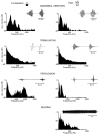Stink Bug Communication and Signal Detection in a Plant Environment
- PMID: 34940147
- PMCID: PMC8705670
- DOI: 10.3390/insects12121058
Stink Bug Communication and Signal Detection in a Plant Environment
Abstract
Plants influenced the evolution of plant-dwelling stink bugs' systems underlying communication with chemical and substrate-borne vibratory signals. Plant volatiles provides cues that increase attractiveness or interfere with the probability of finding a mate in the field. Mechanical properties of herbaceous hosts and associated plants alter the frequency, amplitude, and temporal characteristics of stink bug species and sex-specific vibratory signals. The specificity of pheromone odor tuning has evolved through highly specific odorant receptors located within the receptor membrane. The narrow-band low-frequency characteristics of the signals produced by abdomen vibration and the frequency tuning of the highly sensitive subgenual organ vibration receptors match with filtering properties of the plants enabling optimized communication. A range of less sensitive mechanoreceptors, tuned to lower vibration frequencies, detect signals produced by other mechanisms used at less species-specific levels of communication in a plant environment. Whereas the encoding of frequency-intensity and temporal parameters of stink bug vibratory signals is relatively well investigated at low levels of processing in the ventral nerve cord, processing of this information and its integration with other modalities at higher neuronal levels still needs research attention.
Keywords: Pentatominae stink bugs; biotremology; communication; evolution; host plants; plant-dwelling insects; sensory system; signals; transmission medium.
Conflict of interest statement
The authors declare no conflict of interests.
Figures






References
-
- Grazia J., Schwertner L.A. Stink Bug Classification, Phylogeny, Biology and Reproductive Behavior. In: Čokl A., Borges M., editors. Biorational Control Based on Communication Processes. 1st ed. Volume 1. CRC Press; Boca Raton, FL, USA: 2017. pp. 1–30.
-
- Grazia J., Panizzi A.R., Schwertner L.A., Campos L.A., Garbelotto T.A. Short Views on Insect Genomics and Proteomics. Springer; Singapore: 2015. True Bugs (Heteroptera) of the Neotropics; pp. 681–756.
-
- Panizzi A.R., Lucini T. Biorational Control Based on Communication Processes. Volume 5. CRC Press; Boca Raton, FL, USA: 2017. Host plant-stink bug relationships; pp. 31–85.
-
- Laumann R.A., Bottura Maccagnan D.H., Čokl A. Biorational Control Based on Communication Processes. Volume 1. CRC Press; Boca Raton, FL, USA: 2017. Use of Vibratory Signals for Stink Bug Monitoring and Control; pp. 226–245.
-
- Panizzi A.R., McPherson J.E., James D.G., Javahery M., McPherson R.M. Stink bugs (Pentatomidae) In: Schaefer C.W., Panizzi A.R., editors. Heteroptera of Economic Importance. 1st ed. CRC Press Taylor & Francis Group; Boca Raton, FL, USA: 2000. pp. 421–474.
Publication types
Grants and funding
LinkOut - more resources
Full Text Sources

